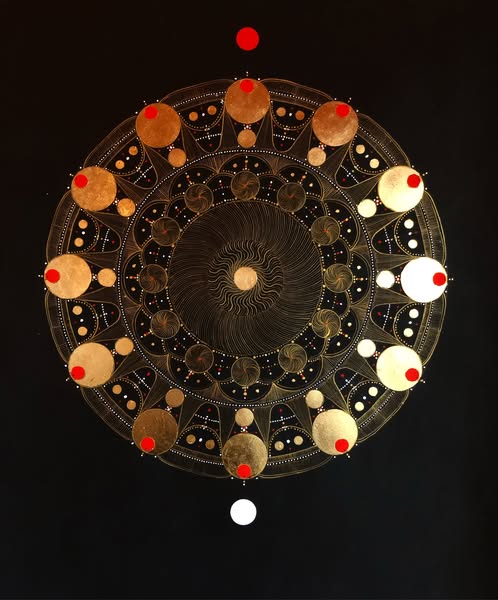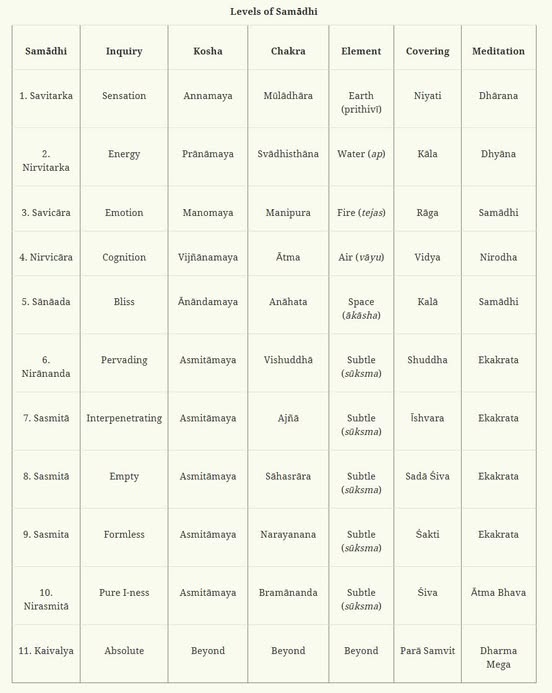The 12-Spoked Radiant Wheel of Fire
In the Śaiva / Śākta Tantrik traditions, the 12-spoked Wheel of Fire represents a great teaching about consciousness, awareness, the subtle energy bodies, the channels and chakra systems.
Dvādaśānta is the name of this twelvefold structure of manifestation and destruction—two of a human beings five innate capacites. The Wheel is a profound symbol with multilayered meanings. Often associated with Bhairava, the fierce form of Shiva, so scary He scares all the fear away!
In advanced Kundalinī and Prāṇic practices of Kashmiri Shaivism, the dvādaśānta refers to a position in space-time twelve inches beyond a given point — often from the heart, eyebrow center, or crown energy plexus. These are sacred thresholds where individual consciousness meets the universal.

The Wheel also expresses the teaching of the twelve Kālīs, a crucial teaching in the awareness of Kundalini. The Goddess Kālī in Her twelve forms are manifestations of time (kāla) and transformation. Each Kālī governs a phase in the pulsation of consciousness — the Five Acts — creation, maintenance, dissolution, concealment, and grace (or revelation), among others.
Real Kundalini Sadhana (dedicated practice) means becoming aware of these fundamental components of the tradition, even if you don’t directly engage, either for lack of experienced guidance, or even personal will. No problem! Just know what is meant by the word Kundalini—it is a luminous starting point to your journey, and a beacon that will bring you back to Still ground when you journey out too far.
The 12 spokes of the wheel are the twelve phases of the inner breath (prāṇa) as it circles through the subtle channels, a mandala of time (kāla-cakra), and a glimpse of the radiant spanda — the vibration or throb of pure consciousness. As the wheel turns, the cosmos cycles through manifestation and reabsorption.
In Śākta Tantra, the wheel is not just a cosmic diagram, but a dynamic mandala of Goddess energy — the energy at the very heart of Spanda’s pulse—the pulse of awakened awareness.
Cross reference with the eleven layers of the subtle unfolding of enlightenment, and consider for yourself (as a kind of welcome to your deepening practice) why the twelfth is not listed. Feel into the contemplation of that subtle aspect of reality. In the tradition, we call this practice—bhavana. Feeling deeply into reality in order to realize oneself.

We talk about enlightenment as if it’s a done deal. But the word ‘enlightenment’ is a European construct, and hardly comes close to touching on the Buddhist or Tantrik concept. In these traditions, enlightenment is layered. A lifelong process that unfolds according to practice, cultivation of awareness and the development of insight.
The chart above shows a common layered interpretation of the samadhi state correlated with its ancillary mode of concentration, the subtle body engaged, the chakra of focus (in a 12-chakra system though only 11 are mentioned here, because 12-dvadasanta is basically synonymous with the Absolute) the gross and subtle elements of engagement and the mode of meditation.

The twelve Kālīs are,, however, twelve transformative stages of Śakti’s unfolding—the Goddess nature rising in you. Kundalini awakening.
These are not sequential time stages alone, but gnostic moments, flashes of awakened awareness where each spoke is a blazing force of time-transcending wisdom. Each Kālī (or śakti) governing a specific transformation of inner consciousness. There are many texts that name these goddesses and link them with specific mantra, practices of prāṇa, and placements within the greater Akasha (tattva).
And in some of the esoteric systems of this Tantrik tradition, the Goddess is also understood to be the Mother of Sound, Vibration, or Letters, giving birth to our innate ability to channel the cosmic resonance through language, first via Sanskrit (nāda), but now in every language on the planet. Kind of gives a whole new meaning to “In the beginning was the Word and the Word was God.” Still is! And always will it be whether we are mindful of our words or not. How much better to be mindful?
How much better to engage a mindful practice of life, and a skillful engagement with reality? The fiery wheel sonic-energetic matrix of Śakti’s own innate powers called icchā, jñāna, and kriyā (will, knowledge, action). They are your own innate powers, too!

…is a Saiva Tantrika, Gyana Yogi and founder of Uma Maheshwara Yoga & Ayurveda. David has an MA in Semiotics, lives in Japan with his family and works as a coach in L & D, devoting his time to developing science-based tools and programs that help people reach the fullest potential of the human condition.
Discover more from REAL YOGA
Subscribe to get the latest posts sent to your email.

